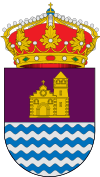Husillos facts for kids
Quick facts for kids
Husillos
|
||
|---|---|---|
 |
||
|
||
| Country | ||
| Autonomous community | ||
| Province | ||
| Municipality | Husillos | |
| Area | ||
| • Total | 16 km2 (6 sq mi) | |
| Population
(2018)
|
||
| • Total | 313 | |
| • Density | 19.6/km2 (50.7/sq mi) | |
| Time zone | UTC+1 (CET) | |
| • Summer (DST) | UTC+2 (CEST) | |
Husillos is a small town, also called a municipality, in northern Spain. It is located in the province of Palencia, within the region of Castile and León. Husillos is about 11 kilometers (7 miles) from the city of Palencia. It is also around 260 kilometers (160 miles) northwest of Madrid, the capital of Spain.
In 2018, about 313 people lived in Husillos. The town covers an area of about 16 square kilometers (6.2 square miles).
Contents
A Glimpse into Husillos' Past
Husillos has a very long and interesting history. Many different groups of people have lived here over thousands of years.
Early Settlers and Roman Times
The first known people to live in this area were the Vacceos. They were a Celtic group. After them, the powerful Romans arrived. They brought their culture and way of life.
Later, the Visigoths settled in the region. Then, during the 8th and 9th centuries, Muslims controlled the area.
The Middle Ages and the Abbey
The more recent history of Husillos began in the late 800s AD. A priest named Gatón helped rebuild the Church of Santa Maria. This church had been destroyed during the time of Muslim rule.
In the 900s, a very important building was constructed. It was called the Abbey of Santa Maria de Fusiellos. This abbey was also known as Santa Maria de la Dehesa Brava.
In the 11th century, King Sancho el Mayor of Navarre gave the town of Husillos to the Bishop of Palencia. This made Husillos an important part of the Palencia region. The Middle Ages were a very successful time for this area.
The Jewish Community in Palencia
For several centuries, a large Jewish community lived in the Palencia region. However, in 1492, they were forced to leave Spain. This happened due to political and religious reasons at the time.
The Relic of Saint Laurent
In the 16th century, King Philip II of Spain built a famous palace. It was called the Palace of San Lorenzo del Escorial, near Madrid. This palace was built after a battle on August 10, 1557, which was Saint Laurent's day.
King Philip II asked the Abbot of Husillos for a special gift. He wanted a relic of Saint Laurent, specifically his foot, for the new palace. The Abbot of Husillos gave it to him as a present.
Later in the 16th century, the abbey itself was moved to a nearby town called Ampudia.
Husillos' Ancient Treasures
The Museum of Archaeology in Madrid holds a very old Roman sarcophagus. A sarcophagus is like a stone coffin. This one dates back to the 2nd century AD. It is decorated with images from the ancient Greek story of Orestes.
This sarcophagus was brought to Spain from Rome. It was found in Husillos in the 1800s. In the year 960, it was reused as the burial place for Count Fernando Ansúrez.
The main church in Husillos is also very important. It has been recognized as a National Monument since 1931.
Husillos' Climate
Husillos has a continental climate. This means it has very different temperatures between summer and winter. Winters can be extremely cold, sometimes reaching -15 degrees Celsius (5 degrees Fahrenheit). Summers can be very hot, with temperatures up to 40 degrees Celsius (104 degrees Fahrenheit).
See also
 In Spanish: Husillos para niños
In Spanish: Husillos para niños


